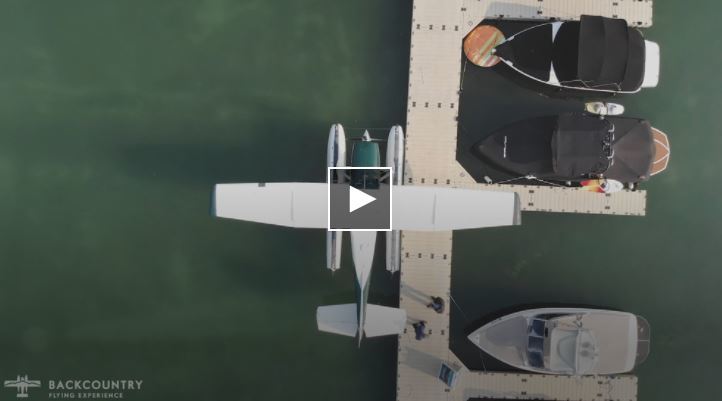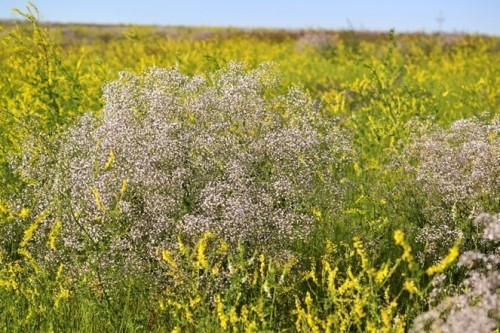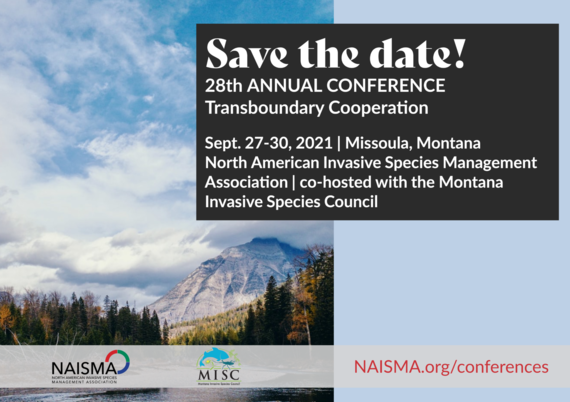|
The Invasive Species Bulletin provides you with all the latest news on invasive species in Montana and the region. Please let us know if you have any suggestions, contributions, questions, corrections, or comments. Email: scriswell@mt.gov
NISAW 2021 Part II
Outreach and Education
May 15-22, 2021
National Invasive Species Awareness Week is an international event
to raise awareness about invasive species, the threat that they pose,
and what can be done to prevent their spread.
North American Invasive Species Association NISAW Webinars
First Montana case of white-nose syndrome detected in Fallon County bat
FWP | 4/30/21
A myotis bat, found dead in Fallon County in southeastern Montana, has been confirmed positive for white-nose syndrome.
The bat was sent to the U.S. Geological Survey National Wildlife Health Center in Madison, WI, for analysis. It tested positive for Pseudogymnoascus destructans (Pd), the fungus that causes white-nose syndrome (WNS) in bats. A pathologist also confirmed characteristic WNS lesions in the skin of the bat...read more.
 NBC Montana | 4/20/21
KALISPELL, Mont. — Keeping aquatic invasive species out of Montana bodies of water, specifically invasive mussels, is very important to protecting the native fish and plant species in the area.
 |
|
MSU Extension Service WEED POST
Baby's Breath (Gypsophila paniculata)
Baby's breath in hay field in early July.
Photo by Inga Hawbaker.
|
MORE NEWS
Sixth Mussel Boat of the Season Intercepted at Anaconda Watercraft Inspection Station
FWP | 4/13/21
Montana’s watercraft inspectors have intercepted six mussel-fouled boats; the latest boat was stopped at the Anaconda watercraft inspection station on Saturday, April 10. Inspectors found dry and dead mussels on a used pontoon boat that had been purchased in Minnesota and was destined for Washington state. Inspectors conducted a hot water decontamination before releasing the boat and notifying officials in Idaho and Washington. In the last two weeks mussels have been found on watercraft returning to Montana from Lake Mohave, Lake Powell and Lake Havasu. These waterbodies are known to be infested with invasive mussels.
Roadside invader: The higher the traffic, the easier the invasive common ragweed disperses
ScienceDaily | 4/14/21
Common ragweed is an annual plant native to parts of the United States and southern Canada. It's an invasive species that has spread to Europe. An important agricultural weed, this plant is particularly well-adapted to living at roadsides, and there are several theories why.
PetSmart Canada stops selling fish, cites federal oversight and invasive species
Global News | 4/12/21
PetSmart confirms they have stopped selling aquarium fish at most of their Canadian stores, in the interim, over concerns due to an invasive species that threatens the Canadian environment. A note posted at the Kelowna, B.C. store states fish sales have been curtailed due to Canada Fisheries and Oceans restrictions and to “help prevent the spread of the zebra mussel.”
Yellowstone Officials Work to Remove Invasive Cisco Fish Species
k2radio.com | 4/15/21
Park officials in Yellowstone National Park report that efforts to protect threatened native cutthroat trout have progressed but that but concerns remain after officials discovered another invasive fish species. Yellowstone fisheries biologist Todd Koel said officials first discovered a small cisco fish native to the Great Lakes two years ago.
The American public is responsible for identifying over a quarter of new invasive species
phys.org | 4/14/21
New research by a team at Resources for the Future (RFF) has found that at least 27% of new pests in the United States were initially detected by members of the general public. The study, which was published today in the journal Conservation Science and Practice, seeks to understand who is identifying new invasive species that make their way into the United States.
CALL FOR ABSTRACTS — 22nd International Conference on Aquatic Invasive Species
April 18-22, 2022 [Hybrid conference with in-person and live virtual components]
Thermae Palace Hotel, Oostende, Belgium
Abstract submission deadline September 30, 2021. The theme of ICAIS 2022 is to demonstrate the interconnectedness of global invasive species issues and inspire international collaboration on research projects at a global scale.
Call for MISC's Next Science Advisory Panel Topic
MISC's Scientific Advisory Panel assembles MISC members, scientists, researchers, natural resource managers, and other experts who provide independent scientific advice to MISC on a wide-range of issues related to invasive species management in Montana.
MISC just wrapped up its latest panel on the Eastern heath snail. If you have an invasive species related scientific question or topic that needs investigation, submit your idea to scriswell@mt.gov. For more information about previous panels, visit https://invasivespecies.mt.gov/misc/Science-Advisory-Panel.
Events
May 15-22, National Invasive Species Awareness Week
May 18-20, North American Invasive Species Forum, Montreal, Quebec
June 2, MISC meeting, virtual
June 5-12, PlayCleanGo Awareness Week
June 12, Gallatin River Weed Pull
Aug. 15-19, Pacific NorthWest Economic Region Summit, Big Sky
Sept. 20-24, Western Regional Panel, Salt Lake City
Sept. 27-30, North American Invasive Species Management Association Conference co-hosted with MISC, Missoula
Oct. 6-7, Invasive Species Council of BC 2021 Invasive Species Research Conference, virtual
Nov. 29-Dec. 2, Innovations in Invasive Species Management Conference and Training, Nashville
April 18-22, 2022, 22nd International Conference on Aquatic Invasive Species, Thermae Palace Hotel, Oostende Belgium

Webinars
May 17-18, Exotic Hornet Identification Basics
June 16, 1:00 P.M. CT, Tree Health Monitoring for Invasive Pests
U.S. EPA IPM webinars - Usually 90-minute programs focused on different IPM topics.
Webinar Recordings
Western Governors Association Invasive Species Data Mobilization Campaign
The IMP Hour monthly online seminars
USACE: Invasive Watermilfoil Management - Nov. 12
Columbia Basin CWMA - Nov. 12
USACE: Flowering Rush - Nov. 4
Purchase access to the 2020 NAISMA Virtual Conference. $75
Publications
Are the “100 of the world’s worst” invasive species also the costliest?
Cuthbert, R., Diagne, C., Haubrock, P. J., Turbelin, A. J., & Courchamp, F. (2021).
Biological invasions are increasing worldwide, damaging ecosystems and socioeconomic sectors. Two decades ago, the “100 of the world’s worst” invasive alien species list was established by the IUCN to improve communications, identifying particularly damaging ‘flagship’ invaders globally. Whilst this list has bolstered invader awareness, whether worst species are especially economically damaging and how they compare to other invaders remain unknown. Here, we quantify invasion costs using the most comprehensive global database compiling them (InvaCost).
Case Studies: Impact and Control of Invasive Mussels at Hydropower Plants (Bureau of Reclamation)
Reclamation’s "Compendium of mussel control research for hydropower plants" paper. Includes all the hydropower specific research projects and links to reports.
High and rising economic costs of biological invasions worldwide
Diagne, C., Leroy, B., Vaissière, AC. et al.
Biological invasions are responsible for substantial biodiversity declines as well as high economic losses to society and monetary expenditures associated with the management of these invasions1,2. The InvaCost database has enabled the generation of a reliable, comprehensive, standardized and easily updatable synthesis of the monetary costs of biological invasions worldwide3. Here we found that the total reported costs of invasions reached a minimum of US$1.288 trillion (2017 US dollars) over the past few decades (1970–2017), with an annual mean cost of US$26.8 billion.
Funding Opportunities
Department of the Interior – Bureau of Land Management Montana/Dakotas Invasive and Noxious Management
Electronically submitted applications must be in no later than 5 p.m., ET, on May 21, 2021
Contact: Kano Williams, Grants Management Specialist, BLM, Montana State Office, 406-896-5229 Office, 505-227-1255 Cell, k1williams@blm.gov
U.S. Fish and Wildlife Service 2021 Implementation of the Quagga and Zebra Mussel Action Plan (QZAP) in the Western United States.
This opportunity will be open for application through June 15, 2021
Please feel free to reach out to barak_shemai@fws.gov.
Western SARE Research and Education Grants
Applications due May 20 noon MDT
APHIS Announces Availability of Funding to Control and Prevent Chronic Wasting Disease
Applications are due in June; specific deadlines vary. Funding decisions will be announced prior to October 1, 2021.
2020-21 Planning Documents and Pest Management Strategic Plan Request for Applications
Applications considered on a rolling basis
Job Opportunities
MT FWP Watercraft Inspectors, various locations. Visit State of Montana Careers and keyword search "watercraft inspector."
|